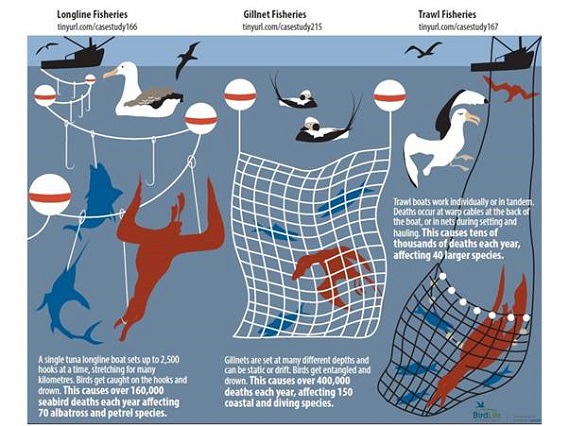By Marguerite Tarzia, BirdLife International
Every day across the world, fishermen and women are out at sea, along coasts or far offshore in search of a good fish catch. Seabirds are irresistibly drawn to their boats, the bait, and the promise of a tasty and easily caught meal. But getting too close to fishing gear is dangerous, and unsuspecting seabirds get accidentally hooked or entangled, and then drown. Unintentional deaths like this are called ‘seabird bycatch’, and it kills hundreds of thousands of seabirds each year. It’s also costly for the fishing industry, as a hooked bird is an expensive missed chance to catch a fish.
The scale of this problem is enormous, yet for some years we have had very simple ways to prevent seabirds from being caught in the first place. Over the last decade, BirdLife’s Albatross Task Force has been on a mission to visit fisheries around the world; collaborating with fisher communities to create solutions to prevent seabird bycatch. So far, they have achieved impressive reductions in the numbers of birds killed in southern Africa and South America. But despite their proven success, it has been a long and steep journey to introduce the same programme in Europe.
Although seabird bycatch is a big problem in Europe, it’s often ignored by governments. We believe at least 200,000 seabirds across the region are caught each year. Europe’s most threatened seabird species, the Critically Endangered Balearic Shearwater is vulnerable to being caught by fishers using longlines (long lengths of fishing lines with hooks) in the Mediterranean and the Atlantic. This is pushing the species down a path towards extinction. In the Baltic, threatened and declining seaduck species, such as Velvet Scoter and Long-tailed Duck are caught in large numbers in fishing nets as they feed by diving below the water’s surface. When you consider this in the context of how European seabird populations are faring, it is clear that this is an important problem that needs solving.
To address this in the EU, the European Commission adopted the Seabird Plan of Action in 2012. It sets out the path for EU Member States to work towards reducing seabird bycatch. This includes recommendations for improving the monitoring of seabird bycatch on board of fishing vessels, and ensuring that fishers use proven ‘safe fishing’ solutions such as those demonstrated by BirdLife’s Albatross Task Force.
Progress towards this on a national level has been extremely slow. While governments continue to grapple with how to deal with the issue on the ground, it was clear to our BirdLife European Marine Partnership that a ‘Seabird Task Force’ was needed in Europe. Our objective? To demonstrate to governments the effectiveness of collecting detailed information on seabird bycatch and to highlight the most problematic areas for seabird bycatch. Furthermore, we also want to demonstrate that through working together with fishers we can develop solutions for their vessels and fishing methods.
BirdLife’s Seabird Task Force was launched this year with the aim to establish a European collaborative approach to tackle bycatch. It is currently made up of two expert teams – one working in the Spanish Mediterranean and one in Lithuania, each led by BirdLife Partners. In Spain, the team is focused on longlines, with fishing vessels operating along the Catalan coast – a particularly important feeding area for the Balearic Shearwater. In Lithuania, the team is working with fishers who use nets to catch Atlantic Cod, a fishery which is known to catch large numbers of birds in the autumn and spring. Our current focus is on monitoring the number of birds caught in both regions and fishing gears so that we understand the problem in greater detail. The next critical step, beginning in 2016 will be to develop solutions with our collaborating fishermen. This will be particularly challenging in Lithuania, because so far there is no accepted ‘best practice’ for reducing seabird bycatch for this type of fishing net. This means we will be at the cutting edge of developing and testing possible solutions as we go.
The Seabird Task Force is an exciting opportunity to work across the European region and bring about real conservation benefits to seabirds. You can read about our progress through our blog, with regular updates by our team. You can also find out about the important bycatch work of BirdLife’s Partner in Portugal (SPEA) here.
See more on the ban here: http://wwf.ru/resources/news/article/eng/13522
Fondation Segré has helped BirdLife launch the Seabird Task Force in Europe, exporting the successful Albatross Task Force model to fisheries in Spain and Lithuania. Through the Seabird Task Force, we have already built strong links with gillnet fishermen in Lithuania and have started to collect bycatch data.
- The original article: Click HERE.
- Related article: Great news for Pacific seabirds and marine mammals as Russia bans driftnet fishery
- Related report: Arctic Migratory Bird Initiative (AMBI) Work Plan 2015-2019






